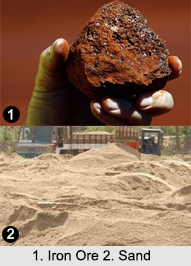 Natural Resources of India refer to the assets of the country. India is rich in natural resources, due to the country`s geographical position. The natural resources vary from dense forests to vast water bodies. Resources of India have significant material and aesthetic values. Therefore, the conservation of Natural Resources of India is being given supreme importance. There are two kinds of resources in India. They are biotic resources and abiotic resources. These resources are described below.
Natural Resources of India refer to the assets of the country. India is rich in natural resources, due to the country`s geographical position. The natural resources vary from dense forests to vast water bodies. Resources of India have significant material and aesthetic values. Therefore, the conservation of Natural Resources of India is being given supreme importance. There are two kinds of resources in India. They are biotic resources and abiotic resources. These resources are described below.
Biotic Resources of India
Biotic resources in India are derived from organic matter and from living creatures including wildlife, crops, forest products etc. These biotic resources are described below:
Forest Resources: Forest resources in India spread over 21.23 percent of the total geographical area of the country. Some of the forest types are Alpine Forest, Tropical Forest, Mangrove Forest and Swamp Forest. Products like paper, drugs, firewood, gums, herbs and spices are collected from forests.
Aquatic Resources: Aquatic resources of India comprise of innumerable species of fishes, which are exported. They are responsible for the thriving of the fishing industry in India. India`s 8129 km long coastline, lakes, ponds, reservoirs and rivers enable the people to relish fishes (like mackerals, catfish, weed-fish, carangids, sardines, croakers and murrels), shrimps, crabs etc.
Fossil Fuel Resources: Fossil fuels have bonds of carbon and hydrogen. These energy sources take millions of years to develop. Coal, oil and natural gas are different fossil fuels found in India. Coal is one of the most important resources of India. Its mining commenced during 1774. At the time, British East India Company was present in India, which operated the Raniganj Coalfield on the western banks of the Damodar River in West Bengal. Coal supplies are essential for manufacturing chemicals, cement, fertilizers and paper. India boasts of being the second largest oil producer after China and most of its oil reserves are based on the shores of Bay of Bengal, north-eastern India, western coast of Mumbai and Rajasthan. Nearly about 30 percent of India`s oil resources are obtained from India itself, more specifically from Rajasthan. The Oil and Natural Gas Corporation Limited (ONGC) is the biggest oil company in India. Natural gas is produced in Gujarat, Andhra Pradesh and Assam. Oil India Limited (OIL) and ONGC are the companies dealing in natural gas.
 Abiotic Resources of India
Abiotic Resources of India
Abiotic resources of India are the ones which are derived from non-organic as well as non-living matter like air and water. Non-living physical and chemical elements like minerals are abiotic resources. They can be classified as metallic, non metallic and minor minerals. These minerals are described below:
Metallic Mineral Resources: Metallic mineral resources found in India include iron ore, chromite, copper, zinc, silver, gold, bauxite, tin and manganese. The world`s largest exporter of iron ore is India, as per the statistics of 2013. Chromite is an oxide of iron; it is obtained from Andhra Pradesh, Karnataka, Odisha, Tamil Nadu, Jharkhand, Nagaland and Manipur and is an important ingredient of alloys as it resists corrosion. Copper has been utilized in the country since ancient ages and is mentioned in `Arthashastra` for making utensils and electrical equipments. Copper is found in Indian states of Jharkhand, Rajasthan and Madhya Pradesh. The lustrous metal zinc is available in Maharashtra, Andhra Pradesh, Bihar and Madhya Pradesh. It is an important part of machinery and is used in electrical and automotive industries. Magnetite and hematite also exist in India. Tamil Nadu, Karnataka, Rajasthan and Andhra Pradesh are reputed for magnetite. Goa, Jharkhand, Chhattisgarh and Odisha are famous for hematite. The Steel Authority of India (SAIL) utilizes iron to produce steel. National Mineral Development Corporation (NMDC) Limited is another important organization governing mineral production.
Non-Metallic Mineral Resources: Non-metallic mineral resources found in India are garnet, wollastonite, sillimanite, pyrophyllite, zircon, vanadium, ilmenite, phosphorite, fluorite, dunite, asbestos, felspar, kaolin, limestone, cadmium, vermiculite, bentonite, gallium, gypsum, perlite and soapstone. Garnet acts as a semi precious stone and as an abrasive. It is utilized for water jet cutting. It is found in Tamil Nadu, Rajasthan, Andhra Pradesh, Jharkhand, Kerala, Odisha and Chattisgarh. Wollastonite is found in Gujarat and Tamil Nadu. It is used as plastic, rubber, paint, etc. Sillimanite is found in large quantities in Rajasthan, Karnataka, Madhya Pradesh, Meghalaya, Andhra Pradesh, Kerala, Odisha, Uttar Pradesh, Tamil Nadu, etc. Pyrophyllite is employed for creating sanitary-ware, electrical insulators, etc. It is found in Rajasthan, Odisha, Andhra Pradesh, Madhya Pradesh, etc.
Minor Mineral Resources: Minor mineral resources found in India include sand, gravel, quartzite, brick earth and marble. Haryana, Rajasthan, Gujarat and Madhya Pradesh are reputed for producing marble.
Renewable and Non-Renewable Resources of India
Resources in India mentioned above can be classified into renewable and non-renewable resources, depending on the rates of their renewal. Renewable resources will not exhaust after use. The fundamental feature of renewable resources is their sustainability. They include water, wind, sun, etc. Non-renewable resources do not replenish themselves at the required rate. They include earth minerals, metal ores, fossil fuels, etc. Thus, sustainable utilization of resources in India will give nature the time and chance to reproduce the excessively used resources.



















